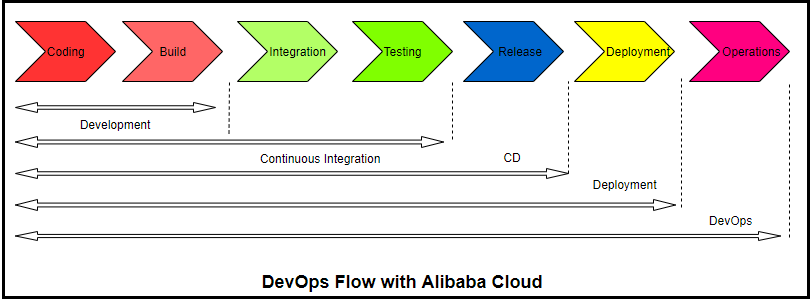By Shantanu Kaushik
DevOps has transformed from a service to culture. Alibaba Cloud and their strategy behind enabling organizations and businesses to adopt and expand, has showcased a well-planned approach. The whole idea is to enable developers to deliver high-quality applications and make the whole process seamless, including building, delivering, and future builds with Continuous Integration and Delivery.
DevOps flows with incremental implementation. This enables an organization to process changes and make adjustments with a pre-defined schedule, when a new and improved system comes along, or when updates become necessary. Alibaba Cloud provides a robust Infrastructure as Code (IAC) platform for developers, so they don't need to worry about anything related to the backend. Alibaba Cloud has worked out a way to introduce a robust infrastructure that provides automatic provisioning options with Server Load Balancer and Elastic Compute Service.
To ensure the best implementation of DevOps with your organization, you need to focus on a few things. Let's take a look at the DevOps flow that needs to be kept in mind for basic operation scenarios while you read this article.

Side-Note: I am going to talk about some practices that are not necessarily common. As a developer or IT decision-maker, you already know that Testing Automation, Continuous Integration, and Continuous Testing are some of the parameters to follow. Well, let's go off the beaten path and talk about some less common implementation practices. The Alibaba Cloud DevOps solution includes most of these metrics for a smoother altogether operational overview with DevOps.
Maintaining a deployment cycle frequency is as important as feeding your pet on-time. Without maintaining a schedule (a very important metric), things can be erratic and uncontrollable. It is very much recommended that you keep track of build frequency and integration frequency. QA or planning phases should also be kept in check. Maintaining quality by keeping defect metrics in check is also an important practice to maintain software quality.
Implementation of DevOps within any organization requires a clear front of what should be used, automated, and how frequently an application should go through Integration. Your team size for specific application modules and what is going through the update also matters, but the tasks to be performed as a consecutive integration takes place must be kept to a certain size. This will enable better and more documented performance during implementation.
Defect escape rate is amongst the most important metric to keep in check while going through the SDLC. You need to know and check on how many defects there are in production and QA.
Let's take a look at a chart that showcases the defect escape rate over a certain time. This report was generated looking at the India Hello World application implementation with DevOps using Alibaba Cloud.

Keeping a close check on this metric will enable better resource utilization by calculating how many defects make it to QA from production. Error rate tracking can lead to a better understanding of problems and performance issues within your application. Any bugs or production problems can be cast to database issues or time exceptions.
Keeping an eye out for a sudden increase in error throw can prove to be crucial in maintaining the up-time of your application.
Managing time between cycles and monitoring the total time taken between each cycle is another important data metric to have. This includes the time from build, to the first deployment, and after that with continuous deployment. A pilot project can be introduced around this to calculate and regulate the time taken. Imagine a scenario where a containerized application has some lag. Now, whether you are using Kubernetes to deploy or any other automation tool, you need to find out what has changed that is causing this lag. If you have certain data already at your disposal, you can easily check the release after the issue started occurring, and take steps to fix it.
Assuming that problems are part of a solution, it is relatively important that they are detected in time. Application monitoring to detect issues before they converge into a system-wide issue is among the best practices one can implement. A well-thought-out monitoring system can help you overcome issues and stop/delay or quickly recover from outages.
Monitoring your application and using Cloud Monitor to check and assist with traffic details is another practice to closely follow. When it comes to Continuous Integration and Deployment, Alibaba Cloud CI-CD incorporates its own Elastic Compute Service and Server Load Balancer to make sure that you can provision enough resources if you wish to provision them.
After deployment, you need to keep a check on access logs and check your cloud application monitor to record traffic spikes and any performance lags that might occur in the aftermath. Reading into the traffic patterns that suggest complete outage or severe high-traffic situations could also reflect some issues with your application.
It could be a SQL query or any other service call, but any such dependency should be closely monitored for a smoother application response.
DevOps is an intelligent service and it completely depends on the user to leverage it. One of the intelligent aspects of DevOps includes, "The Dashboard." A dashboard is a centralized operations hub that captures real-time data and provides insights into the functioning of your complete system. You can rundown reports of all the operations, including test reports, test pass or fail data, many graphs, and logs of overall operations.
Apart from that, database and simple application server configuration changes are also reflected there. This proves that an automated dashboard is no less than a boon for the administrator.
Let's take this opportunity to talk about developing skills as a DevOps engineer. Did you know that Alibaba provides chances to become a certified DevOps engineer? If you're interested, check out this link to move forward in your learning path. This will help you learn and apply a better approach to your DevOps implementation.
Changes made to your configurations might sometimes need additional changes. It's a well-defined process and is executed along with the changes made whenever necessary. These might be required dynamically and are sometimes based on new-found requirements. In this scenario, Integrated Change Management comes into the picture. This enables assessment and correction at a wider level and controls the impact of services.
DevOps and Alibaba Cloud are two terms that are synonymous with each other. The solutions provided by Alibaba Cloud are designed in a way that enables higher availability and resource management. From ECS to the Simple Application server, all of the DevOps solutions offered are extremely efficient and embedded to work in sync.
Implementing DevOps and automating tasks at different levels takes a lot of patience and time. You cannot automate everything in one session and your system won't become efficient overnight. Even if you deploy with the best services and think your system through, you will still need a lot of patience and will have to go through several stages to achieve the perfect system.
When you think of implementing DevOps, there are typical practices to follow, but make sure that you also take care of the basic ones, the ones that work with everything else, but are responsible for providing data and regulating functions efficiently at a larger level. You can read more about DevOps solutions here.
The views expressed herein are for reference only and don't necessarily represent the official views of Alibaba Cloud.
Comparison: Five Automation Tools for DevOps | Using Alibaba Cloud
Infrastructure Transition to DevOps with Alibaba Cloud - Part 1: Container Services

2,599 posts | 764 followers
FollowAlibaba Clouder - September 9, 2020
Alibaba Clouder - September 2, 2020
Alibaba Clouder - June 10, 2020
Alibaba Clouder - October 29, 2020
DavidZhang - December 30, 2020
Alibaba Clouder - September 16, 2020

2,599 posts | 764 followers
Follow Robotic Process Automation (RPA)
Robotic Process Automation (RPA)
Robotic Process Automation (RPA) allows you to automate repetitive tasks and integrate business rules and decisions into processes.
Learn More DevOps Solution
DevOps Solution
Accelerate software development and delivery by integrating DevOps with the cloud
Learn More Alibaba Cloud Flow
Alibaba Cloud Flow
An enterprise-level continuous delivery tool.
Learn More Container Service for Kubernetes
Container Service for Kubernetes
Alibaba Cloud Container Service for Kubernetes is a fully managed cloud container management service that supports native Kubernetes and integrates with other Alibaba Cloud products.
Learn MoreMore Posts by Alibaba Clouder